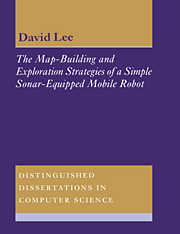 The Map-Building and Exploration Strategies of a Simple Sonar-Equipped Mobile Robot
The Map-Building and Exploration Strategies of a Simple Sonar-Equipped Mobile Robot Published online by Cambridge University Press: 05 March 2012
17.1 Motivation
The exploration strategies presented so far in Part III of this thesis have differed in the extent to which the map has been used to control the navigational choices. Wall-Following (Chapter 12) and Longest Lines (Chapter 16) were both totally reactive, not using the map at all. Supervised Wall-Following (Chapter 14) used the map to detect circumstances in which wall following was becoming ineffective. Chapter 15 showed the results that could be obtained when a human operator used the map to guide the exploration. This chapter will present an exploration strategy in which ARNE's decisions are driven primarily by the information present in the partially-formed map.
The implementation described in Section 17.2 builds on the ideas presented in Section 4.2; ARNE approaches the interesting regions of the environment. The central issue is, of course, the definition of ‘interesting’. The definition adopted here focuses on the edges of free space, the regions in which free cells are next to unknown cells.
Section 17.3 presents the results of experiments to evaluate this strategy and Section 17.4 summarises the results.
17.2 Implementation
The first step in this implementation was to identify the cells on the free-space map which were to be examined. The decision was made that ARNE should approach unknown regions but, to avoid collisions or panic stops, it should not actually enter unknown regions. The interesting cells are therefore those on the boundary between free and unknown space.
To save this book to your Kindle, first ensure [email protected] is added to your Approved Personal Document E-mail List under your Personal Document Settings on the Manage Your Content and Devices page of your Amazon account. Then enter the ‘name’ part of your Kindle email address below. Find out more about saving to your Kindle.
Note you can select to save to either the @free.kindle.com or @kindle.com variations. ‘@free.kindle.com’ emails are free but can only be saved to your device when it is connected to wi-fi. ‘@kindle.com’ emails can be delivered even when you are not connected to wi-fi, but note that service fees apply.
Find out more about the Kindle Personal Document Service.
To save content items to your account, please confirm that you agree to abide by our usage policies. If this is the first time you use this feature, you will be asked to authorise Cambridge Core to connect with your account. Find out more about saving content to Dropbox.
To save content items to your account, please confirm that you agree to abide by our usage policies. If this is the first time you use this feature, you will be asked to authorise Cambridge Core to connect with your account. Find out more about saving content to Google Drive.